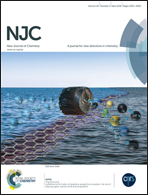Ultrahigh cycling stability and rate capability of ZnFe2O4@graphene hybrid anode prepared through a facile syn-graphenization strategy†
Abstract
A ZnFe2O4–reduced graphene oxide (ZnFe2O4–RGO) hybrid has been successfully synthesized through a facile syn-graphenization strategy. In this preparation procedure, N2H4·H2O works as both a base source and a reductant, and the reduction of graphene oxide (GO) into RGO is accompanied by the formation of ZnFe2O4. In comparison with bare ZnFe2O4, the ZnFe2O4–RGO hybrid shows ultrahigh cycling stability and rate capability as an anode material for lithium ion batteries. The cycling capacity of the ZnFe2O4–RGO hybrid at the 100th cycle is considerably enhanced to 1025 mA h g−1, compared with only 166 mA h g−1 for bare ZnFe2O4. The rate performance can also be significantly improved to 800 mA h g−1 at the current density of 1000 mA g−1. The much better cycling stability and rate capability can be largely attributed to the well dispersed conductive RGO and the tight binding between ZnFe2O4 and RGO, which is a benefit of the subtle syn-graphenization strategy. In addition, the effects of RGO content on the electrochemical performance are presented.


 Please wait while we load your content...
Please wait while we load your content...